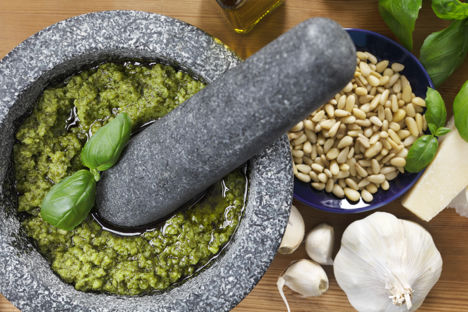
The power of pesto
Luciana Squadrilli takes a closer look at one of Italy’s most famous sauces, before listing the lesser-known variants from other parts of the country.
The power of pesto
Luciana Squadrilli takes a closer look at one of Italy’s most famous sauces, before listing the lesser-known variants from other parts of the country.
The love (and gluttony) for pesto – a traditional recipe from Liguria – is stronger than fear and security checks: recently, Genova Airport allowed passengers flying from the region’s main city to carry one big or two small authentic ‘pesto Genovese’ jars – usually banned onboard for its fluid texture – in their hand baggage in exchange of a small donation in support of the charity Flying Angels Onlus.
The famous green sauce made with basil, oil and cheese is a true local delicacy and one of the most plagiarised recipes in the world, with many existing variations. I’ve even seen a Thai one with Thai basil and fish sauce!
Yet there is no doubt that the original pesto was invented in Liguria, possibly dating back to ancient Rome (even though the first official mention is in a cookbook from 1863) and using locally foraged ingredients such as herbs, garlic, cheese and – later on – olive oil and pine nuts.
The authentic recipe ratified by the Consorzio del Pesto Genovese (Genoese Pesto Consortium) requires the following ingredients: fresh basil, namely the delicately scented Basilico Genovese DOP; extra virgin olive oil, specifically that made in the Riviera Ligure; garlic (many indicate the gentle local one growing in Vessalico as the most appropriate); a mix of Parmigiano Reggiano and Pecorino cheese from Sardinia, an island facing Liguria in the Mediterranean sea and once united under the Kingdom of Sardinia; pine nuts growing in the Mediterranean area and salt. They should be gently hand-crushed in a mortar and pestle, in order not to let the basil wilt and to obtain a coarse, vivid green paste with a gentle fresh smell and taste where garlic and cheese don’t overwhelm the basil.
The sooner you eat fresh pesto, the better it will look and taste. And, of course, never – ever! – heat it. No butter, no cream, no vegetable oil but olive. While it’s often considered good to add flavour to many different recipes including pizza and meats, the authentic pesto should only be used for seasoning pasta (and sometimes the tasty local focaccia) while a generous spoon should be added to the local minestrone. A tempting local variant – pasta alla Genovese – includes potatoes and French beans boiled in the same pot with pasta and added to the plate, mixing everything together with the sauce.
Ligurian people are quite touchy on the subject and they even have a specific ‘code’ for which kind of pasta should be used: trenette (a sort of flat noodles) for long pasta or trofie (thin, hand-twisted pasta) for short pasta. Using spaghetti or other short pasta is looked down upon. Other options include gnocchi, lasagne al pesto (with no cream sauce but prescinseua, a local fresh cheese) and testaroli, a typical product of the Lunigiana area (between Liguria and Toscana) which can be considered a predecessor of pasta; irregular shapes are cut from a flat, round dough made of water, flour and salt and cooked in a traditional terra cotta or cast-iron pan, with a spongy texture resembling the Africaninjera. They are then boiled as normal pasta, drained and served with a generous amount of pesto sauce and grated cheese on top.
Despite this, there are some other pesto recipes found in different Italian regions, which are now commonly approved to season long pasta. As long as they are not confused with the real pesto!
Pistachio pesto – Combine equal quantities of basil and nuts – in this case, shelled pistachios – then add some water and lemon zest to have a rich, sweet and sour sauce.
Rocket pesto – Swap gentle basil with pungent and slightly bitter rocket – which becomes more intense if you use wild rocket – and you’ll get an intense version of pesto, which can also be rounded off with some fresh ricotta.
Wild fennel pesto – Another Sicilian variant, this recipe uses fresh and delicate shoots of wild fennel when it starts to grow in early summer. Crush them with gently roasted almonds and pine nuts, Sicilian Pecorino cheese, extra virgin olive oil, salt and garlic (optional) to obtain a fresh and intensely scented pasta sauce.
